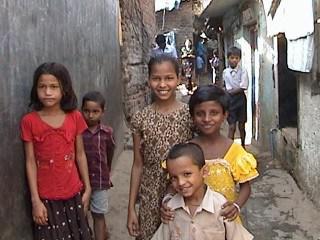
About 7.6 million children in India are living in slums, according to ‘Slums in India – A statistical compendium 2011′ published by the Union government. The report is compiled by the National Buildings Organisation (NBO) of the Ministry of Housing and Urban Poverty Alleviation.
The huge migration of unskilled labours from villages to cities in search of employment has contributed to these statistics. Most of these inhabitants are trapped in poverty and ignored by politicians. Since many live in illegal shacks, they have no sanitation, no piped water, no police protection, no street lighting, no privacy. Instead, they live with overcrowding, crime, ill-health and a constant necessity to pay bribes simply to survive. The children residing here are at the biggest risk. The slums are exploding is clear from the figures below.
States with highest slum population
Children (between 0-6 years)
Maharashtra
1.7 million
Uttar Pradesh
0.97 million
Andhra Pradesh
0.83 million
Madhya Pradesh
0.6 million
West Bengal
0.53 million
Tamil Nadu
0.51 million
More than 20.9 per cent of Chandigarh’s children are in slums. Chandigarh has the highest proportion of slum child population. At least in 23 States more than 10 per cent of the child population stays in slums.
Proportion of slum child population
More than 15%
Between 10% – 15%
Gujarat
Kerala
Bihar
Maharashtra
Rajasthan
Tamil Nadu
Uttar Pradesh
Andhra Pradesh
Delhi
Assam
Uttarakhand
Karnataka
Madhya Pradesh
Meghalaya
Haryana
Orissa
Jharkhand
Punjab
Chhattisgarh
Tripura
Goa
West Bengal
Jammu and Kashmir
Another interesting information that has come up with this report is that the child sex ratios of the slum areas of the 26 States/Union Territories is 921 which is higher than the 903 reported for the non-slum areas. Puducherry has the highest child sex ratio in this group of 988. In fact, in many states the child sex ratio is above 943, which is considered as average national sex ratio at birth. But the ratio is lowest in Punjab at 822, much better than the ratio in the non-slum population of Punjab, which is 790.
The report was compiled by the National Buildings Organisation (NBO) of the Ministry of Housing and Urban Poverty Alleviation. The NBO director D.S Negi said that it was the first time such comprehensive data has been produced. The data published in 2001 census was not representational since has the data of just 654 towns and cities but this time data of 1743 cities and towns has been covered.
The slums are definitely not the place for children to grow owing to the health and sanitation problems that they may face. Pushing them out of slums is also not an option because if one is closed down, another would come up. But it is necessary to make sure that the children living here gain education and don’t lose out on the health facilities. After all, it’s not their crime.
Advertisement Eco World Content From Across The Internet. Featured on EcoPressed
Get ready for another new recycling label system
Featured on EcoPressed
Get ready for another new recycling label system

